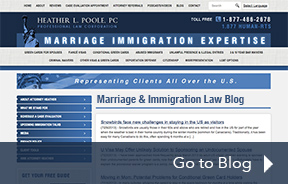How Can I Qualify for a Social Security Card?
To apply for a social security card, you will have to provide original documents showing your age, identity and lawful noncitizen status. If you need the SSN to work, then you will also have to present a valid employment authorization card (EAD) or other proof of the right to work in the U.S. such as current work-related visa and an I-94 card.
Note: Once an adjustment of status (green card) application is filed based on an immediately available or current visa number, you should be able to qualify to get the EAD within a matter of months. After you pick up the EAD from CIS or after it is sent to you, use this to show to your local social security office to show that you are eligible for a SSN and card.
The social security administration will only issue a social security card and number for non-work purposes if:
- If a federal law requires that you show your Social Security number to get a particular benefit or service; or
- If a state or local law requires you to show your Social Security number to get general assistance benefits.
If you are living outside of the U.S., you may apply for a social security card at the same time as applying for an immigrant visa. See www.ssa.gov for more information about this special service.
What Will CIS (INS) do if I use a false social security card or number? Will it hurt my immigration case or status?
Using a false social security number for purposes of obtaining work or some other non-immigration benefit will not hurt your immigration case. You are not supposed to be working unlawfully and that raises a separate issue as to whether you can qualify for a green card through the adjustment of status process. But, as long as you did not use a false social security number to defraud or misrepresent your identity to CIS or INS, then your immigration case should not be hurt just by the fact that you used a false social security number to gain employment.
However, if a CIS or INS officer asks you if you have ever used a false social security number and you lie to the officer, that could hurt your case because it reflects on your credibility and moral character and adjustment of status is still a discretionary decision. If you lie on the employer’s I-9 form, by putting a false social security number, then you must be charged and convicted of civil document fraud, which is a rare occurence, for this to actually harm your case.
My Employer Received a “No-Match Letter” from the Social Security Administration because I was using another person’s social security number. What can I do? What can my employer do?
The SSA annually reviews W-2 forms and credits social security earnings to workers. If a name or a Social Security Number (SSN) on a W-2 form does not match SSA records, the Social Security earnings go into a suspense file while the SSA works to resolve discrepancies. In recent years, the SSA has been unable to match employee information with SSA records for 6-7 million workers a year. SSA has deposited over $327 billion dollars in the earnings suspense file as a result of the cumulative effect of these no-matches. The no-match letters are an annual attempt by the agency to reduce the earning suspense file and clean up its database to prepare for the release of its new Internet based Social Security Number Verification System.
Previously, the SSA would send no-match letters to employers when information submitted for at least 10% of their employees did not match SSA records. Until 2000, that system resulted in about 40,000 letters sent annually to employers. In 2001, that number jumped to 110,000 letters, with 1 in 60 employers receiving no-match letters. In 2002, the SSA sent a letter to every employer who had at least one employee whose information did not match the SSA’s records. This change in practice resulted in the SSA issuing roughly 900,000 letters, the equivalent of 1 in 8 employers receiving these letters. Approximately 7 million workers were included on these letters.
The sheer volume of no-match letters sent out in 2002, combined with language in the no-match letter indicating that the Internal Revenue Service (IRS) could fine an employer for each incorrectly reported social security number, resulted in panic and uncertainty among both employers and employees. Despite language indicating otherwise, the letters were confused with notification of immigration violations. Even savvy employers were very confused as to how to respond to the letters and at the same time obey the immigrant worker protection laws. Some employers immediately fired individuals appearing on the list. Others gave employees a limited timeframe to correct the inconsistent information. In some cases, employees resigned immediately after being notified of their no-match status. Reports indicate that U.S. employers lost thousands of workers due to the effects of the no-match letter.
In 2003, the SSA significantly reduced the number of no-match letters issued by sending letters only to those employers with more than 10 employees with mismatched information or whose mismatched employees represented ½ of 1% of the W-2 forms filed with SSA. In those two years, the SSA sent out approximately 130,000 letters roughly 770,000 less than in 2002. However, even with the change in determining which employers should receive letters, the total number of employees referenced in the 2003 letters did not drop significantly from the numbers reached in 2002.
In 2004, the SSA sent out roughly the same number of no-match letters as in 2003. However, it altered its criteria for which employers received letters. The SSA sent no-match letters in instances where employers employed 11 to 2,200 staff and 11 or more earnings reports had a mismatch between SSN and the employee name. No-match letters were not sent for employers who employed 10 or fewer staff. For organizations with more than 2,200 employees, the SSA only sent no-match letters if there were reported earnings to SSNs that did not match the employee names for more than 0.5% of employees
The 2004 no-match letter also contained, and improved upon, many of the positive revisions made in 2003. Most importantly, the letter did not include any reference to IRS fines. The SSA also marked as ?Important? and drew employer attention to a first-page paragraph explaining that the letter was not a statement about the employee’s immigration status. The leading paragraph on the second page advised employers not to take any adverse action against an employee just because the SSN appeared on the no-match list, and that taking adverse action could violate state and federal law and subject the employer to legal consequences. The letter also further clarified that the request for a 60 day response from employers was for the convenience of the agency and was not a mandate. As in previous years, the letter informed the employer that some of the information reported on the Form W-2 did not match the SSA’s records, and that the mismatch could have resulted from a typographical error or human mistake.
In addition to the reduction in volume of letters and the content changes to the employer letter, the SSA also sent a no-match letter to each ?no-match? employee about two to three weeks before it sent the no-match letter to the employer. If the SSA does not have a valid address listed for a particular employee, the agency will send the letter directly to the employer. Employers should note that even if an employee corrects his or her SSN information before the employer no-match letters are sent, the employer would still receive a letter listing that employee as a no-match. The receipt by the employer of this no-match letter is a function of the process of producing the letters and has nothing to do with the validity of the employee’s corrected information.
The above information is general in nature and is not intended to be considered or relied upon as legal advice. You should always consult an attorney to determine if what immigration options are available to you and to determine how any recent changes in the law could affect your situation.
Questions or comments? Contact us at info@humanrightsattorney.com.
TO BOOK AN ATTORNEY CASE EVALUATION APPOINTMENT,
CALL: 877.486.2678






